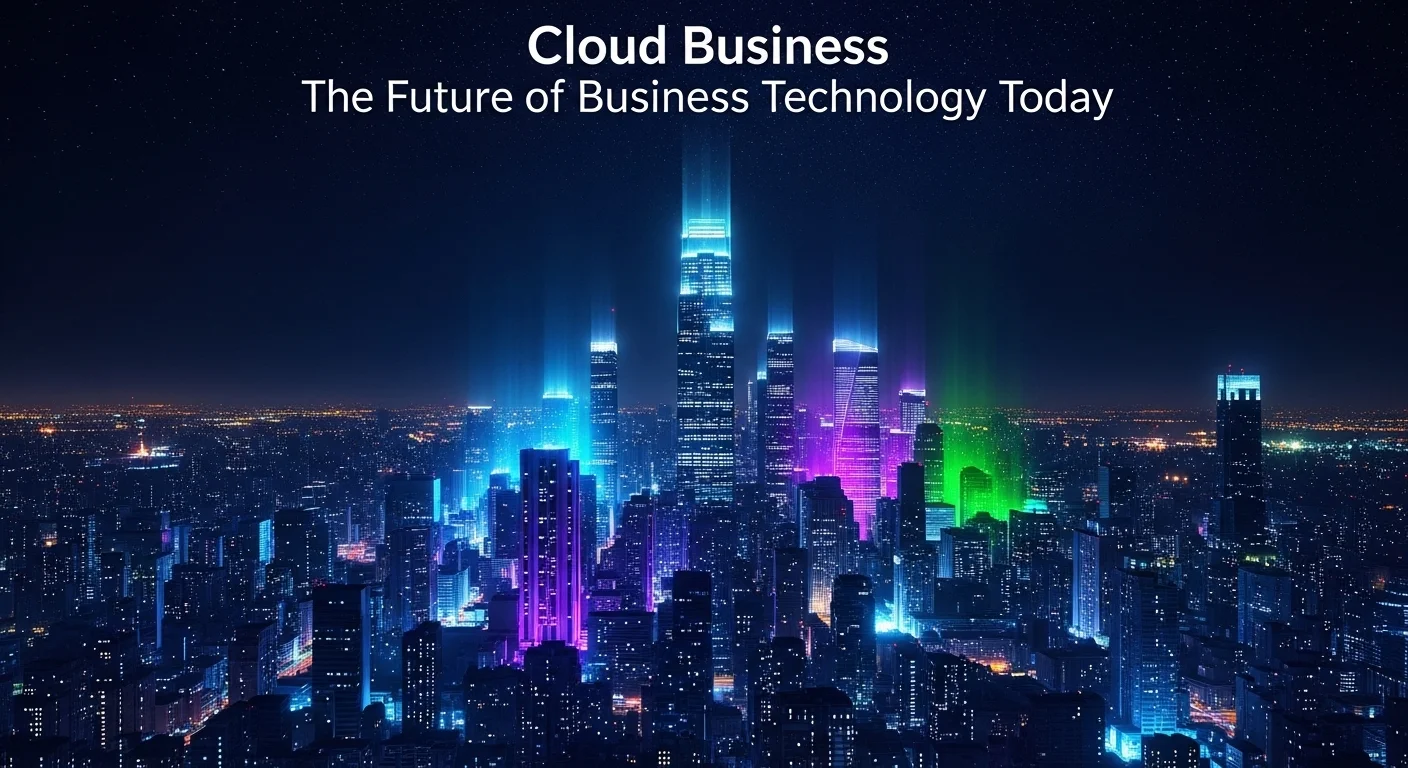What is Cloud Business? A Real-World Guide to Digital Transformation

Executive Summary
When people hear 'Cloud Business,' they often think it's just a tech buzzword. But from my years in the field, I can tell you it’s the most significant shift in business operations I've ever seen. It's about moving away from buying and maintaining expensive, clunky hardware in your office to accessing powerful tools and services over the internet, on demand. Think of it like switching from owning a power plant to just plugging into the grid. This simple change gives businesses of any size incredible agility, the power to scale up or down in minutes, and a much more predictable cost structure. In this article, I'm going to break down the transformative power of the cloud. We’ll look at the essential services that are fueling innovation today, how data intelligence in the cloud is changing decision-making, and why having a cloud-based plan for business continuity is something you can't afford to ignore. If you want to understand how modern businesses thrive, this guide will give you the practical insights you need to get ahead.
Table of Contents
Table of Contents
- What is Cloud Business and why should you care?
- The Core Pillars of a Cloud-First Mindset
- Real-World Applications and Game-Changing Benefits
What is Cloud Business and why should you care?
In my line of work, I often get asked, 'What exactly *is* a Cloud Business?' Put simply, it’s a way of running your company using technology services delivered over the internet. Instead of buying, housing, and maintaining your own physical servers and software, you 'rent' them from a specialized provider like Amazon Web Services (AWS), Microsoft Azure, or Google Cloud. This isn't just an IT upgrade; it’s a fundamental change in business strategy. I've seen small startups leverage this model to access the same computing power as a global corporation, leveling the playing field in a way that was unthinkable 20 years ago. This shift from massive upfront capital investment (CapEx) to a more flexible, pay-as-you-go operational cost (OpEx) is the engine behind so much of today's tech innovation, from AI to the Internet of Things (IoT).
The real magic of running a business in the cloud comes down to three things I've seen transform companies time and again: scalability, flexibility, and efficiency. Scalability means you can instantly get more or less computing power when you need it. Imagine an e-commerce site on Black Friday. In the old days, you’d have to buy servers that could handle that peak traffic, even though they'd sit idle the rest of the year. With the cloud, you can scale up for the rush and scale back down when it's over, only paying for what you actually use. Flexibility comes from the incredible menu of services available. We generally talk about three main 'flavors':
- Infrastructure as a Service (IaaS): This is like leasing the basic building blocks—virtual servers, storage, networking. You get full control to build what you want on top of it.
- Platform as a Service (PaaS): This gives you a complete environment to build and run your own applications without worrying about the underlying hardware or operating systems. It’s a huge time-saver for development teams.
- Software as a Service (SaaS): This is the most common model. You're using a ready-made application directly from your web browser, like Salesforce for CRM or Microsoft 365 for productivity.
This range of choices lets you pick the perfect tool for the job, every time.
The Core Pillars of a Cloud-First Mindset
To really succeed, you need to think 'cloud-first.' This means choosing the right business cloud platform and services to build upon. A cloud platform isn't just a bunch of remote servers; it’s a whole ecosystem of interconnected tools designed to be secure, reliable, and powerful. When I advise clients on picking a platform, we look beyond the price. We discuss performance, security standards, and what unique tools they offer. A business focused on AI, for example, might lean towards a platform known for its machine-learning capabilities.
The cloud business services on these platforms are what truly unlock potential. We're talking about much more than just storage. You can access sophisticated databases, serverless functions that run code without managing any servers, and content delivery networks (CDNs) that make your website fast for users anywhere in the world. I've seen a startup launch a global video streaming app in weeks, not years, by piecing together these pre-built services. This access to ready-made cloud based services for business lets your team focus on what matters: creating an amazing product for your customers, not managing infrastructure.
Real-World Applications and Game-Changing Benefits
Cloud business isn't a niche; it's everywhere. Financial firms use it for instant risk analysis. Healthcare organizations use it to power telemedicine and securely analyze patient data to speed up research. Retailers rely on it to run their online stores and personalize shopping experiences. The common thread is using data more effectively and operating with a new level of speed.
One of the most powerful outcomes I've witnessed is the rise of business intelligence in the cloud. Before, company data was often trapped in different departments on different systems. By bringing it all together in the cloud, businesses can use powerful analytics tools to find incredible insights. Suddenly, people in marketing, finance, and sales—not just data scientists—can pull up dashboards, run reports, and make smarter, data-driven decisions. It turns raw information into a real competitive advantage.
Finally, let's talk about something crucial: resilience. Having a plan for cloud based business continuity is no longer optional. In the past, setting up a disaster recovery site was incredibly expensive and complex. Cloud providers have a global network of data centers with built-in redundancy. This means you can back up your critical systems and data to another geographic region for a fraction of the traditional cost. If a disaster strikes—a fire, a flood, or a cyberattack—you can switch over to your cloud replica and keep your business running with minimal disruption. This kind of robust protection gives you peace of mind and builds trust with your customers, ensuring your business can weather any storm.

Your Complete Roadmap to Cloud Business Solutions
Making the leap to the cloud is one of the most strategic moves a business can make today. But a successful journey requires more than just good intentions; it needs a clear plan. I've guided dozens of organizations through this process, and I've learned that having a phased roadmap is key. This guide breaks down the technical methods and business strategies I've seen work best, helping you make smart decisions and get the most from your cloud investment.
The Cloud Migration Journey: A Step-by-Step Approach
Migrating to the cloud isn't like flipping a switch. It's a careful process that, when done right, feels more like a controlled ascent than a risky jump. Here are the phases I always walk my clients through:
- Assessment and Discovery: First, you have to know what you have. We start by taking a complete inventory of your current applications, servers, and data. There are great tools that can map everything out, showing you how different systems are connected. The goal here is to assess each piece of your IT puzzle and decide the best way to move it. Sometimes you 'rehost' (lift-and-shift), other times you 'refactor' (rebuild it for the cloud), and sometimes you just 'retire' old systems.
- Planning and Design: With a clear picture of the 'what,' we plan the 'how.' This is where we choose the right business cloud platform—AWS, Azure, or Google Cloud—based on your specific goals. Then comes the fun part: designing your new home in the cloud. We map out the network, set up security rules, define who has access to what, and, crucially, we design for cloud based business continuity from day one. Planning for failure is the best way to ensure you don't.
- Migration and Execution: Now, we start moving. I always recommend starting small, migrating less critical applications first to build confidence and iron out any kinks. Cloud providers offer amazing tools that can automate much of this process. Throughout the move, constant testing is vital to make sure everything works just as it should, if not better, in its new environment.
- Optimization and Innovation: Getting to the cloud isn't the finish line; it's the starting line. Once you're there, the real work begins. This is a continuous cycle of monitoring your costs and performance, making sure you're not paying for resources you don't need. But more excitingly, this is where you start using the full suite of cloud business services to innovate. You can modernize old apps, build new cloud-native solutions, and unleash the power of business intelligence in the cloud to discover new opportunities.
Comparing Cloud Platforms: Finding the Right Fit
Choosing a cloud provider is a big decision. While there are many players, the big three—AWS, Microsoft Azure, and Google Cloud (GCP)—each have distinct personalities:
- Amazon Web Services (AWS): The original market leader. I find AWS is often the default choice because of its massive portfolio of services. If you need a mature, proven platform with a tool for nearly everything, AWS is a rock-solid bet.
- Microsoft Azure: For companies that live and breathe Microsoft, Azure is a natural fit. Its integration with on-premise Windows systems and enterprise tools like Microsoft 365 is seamless, making it a powerhouse for hybrid cloud setups.
- Google Cloud Platform (GCP): Google's expertise shines in data, machine learning, and modern application development with Kubernetes. I see companies that are laser-focused on data-driven innovation and cutting-edge tech gravitate towards GCP.
Beyond the provider, you'll choose the right service model for each task:
- IaaS (Infrastructure as a Service): Gives you the most control. It's like renting the land and building your own house. Perfect for complex systems or when you need to migrate an old application without changing it.
- PaaS (Platform as a Service): The provider handles the infrastructure, so you can just focus on building your app. It’s like renting a fully equipped workshop. This drastically speeds up development.
- SaaS (Software as a Service): The easiest model. You just use the software. Think of it like renting a fully furnished apartment. This is for everyday business needs like email or CRM.
In my experience, most businesses end up using a mix of services from different providers (multi-cloud) or blending their on-premise systems with the public cloud (hybrid cloud). These strategies offer the most flexibility and help you avoid being locked into a single vendor.
The Mindset Shift: New Methods for a New Era
Success in the cloud requires adopting new ways of working. DevOps is a culture that brings your development and operations teams together, using automation to release better software faster. It’s the engine of agility in the cloud. Another critical practice is FinOps, or Cloud Financial Operations. The pay-as-you-go model is great, but it requires a new level of discipline. FinOps brings finance and tech teams together to track, manage, and optimize cloud spending, ensuring you get the most bang for your buck.
Technically, the goal is to build cloud-native applications using tools like containers (Docker) and microservices. This means breaking down large, monolithic applications into smaller, independent services that are easier to build, scale, and maintain. A comprehensive business cloud platform provides all the cloud based services for business you need to make this happen. Ultimately, combining these modern architectures with powerful business intelligence and a solid plan for business continuity is what separates the companies that just use the cloud from those that are transformed by it.

Pro Tips for Mastering Your Cloud Business Experience
Getting your business onto the cloud is a great first step, but truly mastering it is an ongoing journey. To get the most value from your investment, you need to focus on continuous improvement. Over the years, I've seen what works and what doesn't. Here are some practical strategies and hard-won lessons for optimizing your cloud security, costs, and innovation. Think of these as the insider tips that turn a good cloud setup into a great one.
Best Practices for Cloud Security and Compliance
The single biggest mistake I see companies make is treating cloud security like their old on-premise security. In the cloud, security is a partnership. The provider secures the cloud itself, but you are responsible for securing what you put *in* the cloud. Here’s how to do it right:
- Adopt a 'Zero Trust' Mindset: The old idea of a secure network wall is dead. In the cloud, you have to assume that threats can come from anywhere. A Zero Trust model means you 'never trust, always verify.' Every single request for access must be strictly authenticated and authorized, no matter where it comes from. This drastically limits an attacker's ability to move around if they do get in.
- Become a Master of Identity and Access Management (IAM): IAM is your new front door, and you need to be the best bouncer. Always follow the principle of least privilege: give people and services the absolute minimum permissions they need to do their job, and nothing more. Always enforce Multi-Factor Authentication (MFA). It’s one of the simplest and most effective security layers you can add.
- Encrypt Everything that Matters: Your data is your crown jewel. Make sure it's encrypted both when it's being stored (at rest) and when it's moving between services (in transit). Most cloud business services make this incredibly easy to implement, so there's no excuse not to.
- Automate Your Compliance and Monitoring: Trying to manually keep track of compliance with regulations like GDPR or HIPAA is a recipe for disaster. Use the tools available on your business cloud platform to continuously scan your environment for security risks and misconfigurations. Set up automated alerts so you can respond to issues in real-time, not weeks later.
Strategies for Taming Cloud Costs
The cloud's pay-as-you-go model is a double-edged sword. It offers amazing efficiency, but without careful oversight, costs can feel like a running tap. A smart FinOps strategy is essential.
- Shine a Light on Your Spending: You can't control what you can't see. The first step is to use the cost management tools from your cloud provider. Tag all of your resources by project, team, or application. This is the only way to know exactly where your money is going and to spot where it's being wasted.
- Right-Size, Don't Over-Size: The most common source of waste I see is paying for oversized resources. Teams often provision a massive virtual server 'just in case,' but it ends up being mostly idle. Monitor your usage and shrink or shut down anything that's underutilized. Using auto-scaling, a key feature of many cloud based services for business, is a great way to match resources to real-time demand automatically.
- Commit and Save with Reserved Plans: If you have workloads that run predictably around the clock, don't pay the on-demand price. Talk to your provider about Reserved Instances or Savings Plans. By committing to one or three years of usage, you can get massive discounts—often over 70%.
- Go Serverless Where You Can: For many tasks, you don't need a server running 24/7. Serverless technologies let you run code in response to events and you only pay for the fraction of a second it's actually running. Shifting to serverless and other managed cloud business services not only cuts costs but also reduces the operational burden on your team.
Using the Cloud as an Engine for Innovation
The real prize of the cloud isn't just saving money on IT; it's the ability to innovate faster than ever before.
- Unleash Your Data with BI and AI: The cloud puts world-class data tools at your fingertips. Use your provider’s business intelligence cloud computing services to turn your data into actionable insights with interactive dashboards. Don't be afraid to experiment with AI and Machine Learning services. You can build predictive models or add intelligent features to your products with surprisingly little effort.
- Build for Agility with Containers: To move fast, you need to build applications in a modern way. Using containers (like Docker) and orchestrating them with a system like Kubernetes is the standard for a reason. This architecture, fully supported by every major business cloud platform, helps you develop, deploy, and scale applications with incredible speed and reliability.
- Build on a Foundation of Resilience: You can't innovate if you're constantly worried about things breaking. Make cloud based business continuity a core part of your culture. Regularly test your disaster recovery plans. Run drills to make sure your team and your systems are ready for a real-world outage. A resilient system gives your teams the confidence to experiment and push boundaries. By getting security, costs, and innovation right, you'll build a technology experience that is not just efficient, but a true catalyst for growth.
Expert Reviews & Testimonials
Sarah Johnson, Small Business Owner ⭐⭐⭐⭐
As a small business owner, the cloud always felt intimidating. This article finally made it click. The section on taming costs was a real eye-opener for me. I wish there were a few more examples for non-tech-savvy people, but it was incredibly helpful!
Mike Chen, IT Consultant ⭐⭐⭐⭐⭐
This is a fantastic, no-nonsense guide to Cloud Business. I especially appreciated the real-world comparison of AWS, Azure, and GCP. It's concise and practical. I'll be sharing this with my clients who are considering a migration. Great work.
Emma Davis, Tech Lead ⭐⭐⭐⭐⭐
Finally, an article that goes beyond the buzzwords! The author clearly has hands-on experience. The pro tips on security and FinOps are spot on and reflect the real challenges we face daily. This is a must-read for any tech professional in the cloud space.



